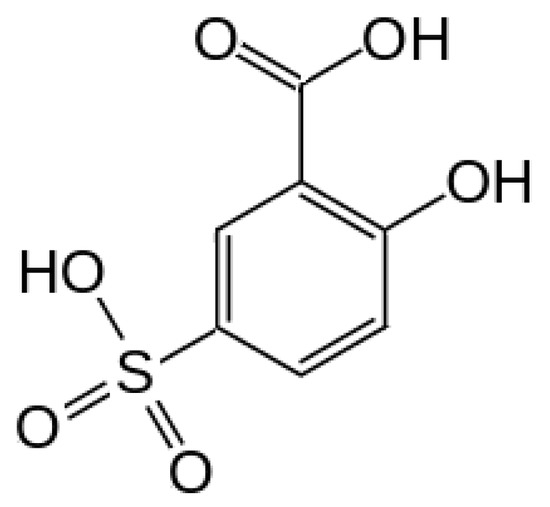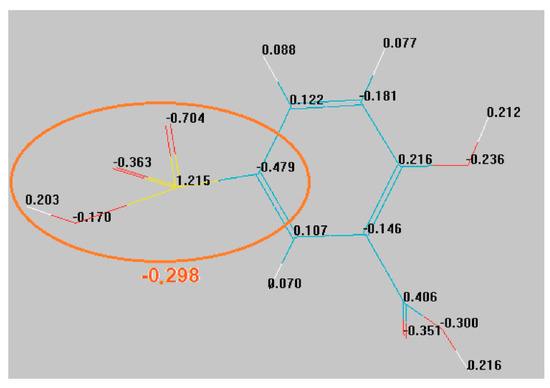This work was intended to enlarge the gates toward green organic technologies at room temperature, searching for new types of semiconductors with low toxicity and simple molecular organization. In our previous studies, para-aminobenzoic acid was used to construct a p-type green semiconductor. A non-toxic organic compound, acting as an electron donor, is sulpho-salicylic acid. SSA can be efficiently attached to the external shell of a ferrite (Fe3O4) nanocore, providing Fe3O4–SSA nanoparticles. This is a N-Type Organic Semiconductor - made by green technologies and used to construct a simple thin film transistor.
- Semiconductors
- Organic electronics
- Nano-core shell
1. Introduction
The latest advances in materials science successfully serve nanoelectronics’ interests, such as flexible electronic devices with elastomeric substrates [1], field-effect transistors attached to a gold electrode sensing pad for deoxyribonucleic acid hybridization [2], carbon-related materials such as diamond [3], or nanocomposites serving as efficient hole-transporting layers for organic solar cells [4]. Some organic materials present superior performance than inorganic materials for thin-film transistors (TFTs) [5]. A convenient method for the deposition of organic materials is dip-coating [6]. Polymers such as pentacene are the most widely used organic semiconductors for p-type materials nowadays [7], as well as for n-type materials under special conditions [8]. The precursors of pentacene are polycyclic aromatic hydrocarbons (PAHs), and their toxicity comes from the ability of these PAHs to bind to deoxyribonucleic acid inside cells [9]. Therefore, the green technologies are much sought after for solar cells [10] and other electronic devices [11]. OLED for display purposes was eco-friendly defined in terms of low power consumption and long lifetime [12]. However, after carrying out a search, zero results were returned for green technologies for n-type organic transistors, except one regarding green solvents [13].
This work was intended to enlarge the gates toward green organic technologies at room temperature, searching for new types of semiconductors with low toxicity and simple molecular organization. In our previous studies, para-aminobenzoic acid was used to construct a p-type green semiconductor [14]. A non-toxic organic compound, acting as an electron donor, is sulpho-salicylic acid (SSA), the chemical structure of which is presented in Figure 1. SSA can be efficiently attached to the external shell of a ferrite (Fe3O4) nanocore, providing Fe3O4–SSA nanoparticles using self-assembling techniques [15]. Essentially, an Fe3O4 nanocore represents an intrinsic semiconductor and SSA is suitable for organic electronic devices due to its molecular conjugation [16]. The self-assembly of SSA onto the external shell of ferrite nanoparticles easily occurs during the synthesis step, yielding core–shell nanoparticles with a good dispersibility in water. To create a demonstrator, we used a low-cost technology to deposit Fe3O4–SSA onto a compatible insulator on indium tin oxide (ITO)-coated glass. Finally, we tested the n-type characteristics of the Fe3O4–SSA film using a point-contact transistor. The Fe3O4–SSA film was contacted by two probes, i.e., the source and drain, and the ITO film was contacted by a third probe, i.e., the gate. This point-contact transistor, also named pseudo-MOS (Metal Oxide Semiconductor) or Ψ-MOSFET (Metal Oxide Semiconductor Field Effect Transistor) transistor, is specifically used for the in-situ electrical characterization of the conduction in thin semiconductors on insulators [17][18], including organic biomaterials [19][20].

Figure 1. The chemical structure of sulpho-salicylic acid (SSA).
2. The n-Type Characteristics and the Low Toxicity of the Fe3O4–SSA Film
In this section, the n-type characteristics of the Fe3O4–SSA compound were discussed as the electron donor.
Some specific conduction mechanisms through the SSA molecules from the external shells may arise. For this purpose, an SSA molecule was simulated by HyperChem molecular modeling software, indicating the following electric charge distribution (Figure 2).

Figure 2. The simulation results of the electrical charge distribution inside the SSA molecule.
Inside the SSA molecule, the local electronic charge density, expressed by a normalized value at the elementary charge, was computed for each atom. The neutrality condition was fulfilled, because the global electrical charge of the SSA molecule was +2.932–2.93 ≅ 0. However, the sulphonate group, SO3H, possessed a net negative electronic charge density of −0.298 (Figure 2). This augments the argument to consider the SSA molecule an electron donor, subsequently offering the n-type behavior of the Fe3O4–SSA film. On the other hand, the Fe3O4 film or magnetite was indexed as a semiconductor with a Fermi energy of 3.64 eV and band gap energy of 2.2 eV [21]. Hence, the Fe3O4 core–shell substrate plays a significant role as a matrix for an intrinsic semiconductor.
The second discussion concerns the low toxicity of the Fe3O4–SSA compound and its precursors during the technological flow. Ferrite has a low toxicity and by degradation, it can generate Fe+, O− ions, usually encountered in the human body and the environment.
A quantitative parameter for the evaluation of toxicity is the lethal dose, defined as a given quantity for the studied toxic substance that is administered per kilogram of the body weight of rats, at which a given percentage of the treated test animals die. The median lethal dose, denoted LD50, corresponds to a mortality of 50% from the tested animals after inoculation with the substance [22]. Previously, various studies were performed to evaluate the toxicity of SSA [23]. For rats, the LD50 for SSA was established at 700 mg/kg [22]. This value indicates much lower toxicity of SSA than that of PAHs, such benzo[k]fluoranthene (LD50 = 14 μg/kg) or other PAHs with an LD50 below 90 μg/kg [24]. Even in recent studies, a high cytotoxicity of polyphenolic compounds has been revealed [25], while polyphenols are specifically used for organic semiconductors applied in flexible electronics [26]. On the other hand, the precursor of SSA is salicylic acid—a veritable green compound that acts as a plant hormone or vascular drug [27].
3. Conclusions
We demonstrated that an organic transistor with an Fe3O4–SSA film is operational. Obviously, many functional parameters have to be further optimized in the coming years to surpass the performance of the current OTFTs.
Herein, we investigated Fe3O4–SSA material as a candidate for green organic transistors. For this purpose, the synthesis of the Fe3O4–SSA material was based on co-precipitation. The FT-IR spectra confirmed the existence of SSA, while the TEM imaging captured the Fe3O4–SSA aggregates. The Fe3O4–SSA nanoparticles had good dispersion stability according to a zeta potential of +45.3 mV.
The point-contact OTFT transistor with an Fe3O4–SSA film presented an increasing drain current as the positive gate voltage increased, demonstrating the n-type character of the film. This was the main experimental argument for inducing an electron accumulation channel with a positive gate voltage. Compared to other OTFTs, our Fe3O4–SSA transistor presented a threshold voltage of approximately 5 V and an ION/IOFF ratio of 500, close to the parameters of a classical pentacene OTFT.
This entry is adapted from the peer-reviewed paper 10.3390/nano10091787
References
- Zhou, H.; Qin, W.; Yu, Q.; Cheng, H.; Yu, X.; Wu, H. Transfer Printing and its Applications in Flexible Electronic Devices. Nanomaterials 2019, 9, 283.
- Crossley, L.; Attoye, B.; Vezza, V.; Blair, E.; Corrigan, D.K.; Hannah, S. Establishing a Field-Effect Transistor Sensor for the Detection of Mutations in the Tumour Protein 53 Gene (TP53)—An Electrochemical Optimisation Approach. Biosensors 2019, 9, 141.
- Ravariu, C. Special features of the nothing on insulator transistor simulated with diamond lateral islands. Rom. Rep. Phys. 2018, 70, 1–10.
- Ramasamy, M.S.; Ryu, K.Y.; Lim, J.W.; Bibi, A.; Kwon, H.; Lee, J.-E.; Kim, D.H.; Kim, K. Solution-Processed PEDOT:PSS/MoS2 Nanocomposites as Efficient Hole-Transporting Layers for Organic Solar Cells. Nanomaterials 2019, 9, 1328.
- Agarwal, R.; Agarwal, A.K.; Mazhari, B. Estimation of carrier mobility at organic semiconductor/insulator interface using an asymmetric capacitive test structure. AIP Adv. 2016, 6, 045017.
- Chaudhari, A.K.; Souza, B.E.; Tana, J.-C. Electrochromic thin films of Zn-based MOF-74 nanocrystals facilely grown on flexible conducting substrates at room temperature featured. APL Mater. 2019, 7, 081101.
- Fan, C.-L.; Shang, M.-C.; Wang, S.-J.; Hsia, M.-Y.; Lee, W.-D.; Huang, B.-R. Investigation of Rapid Low-Power Microwave-Induction Heating Scheme on the Cross-Linking Process of the Poly(4-vinylphenol) for the Gate Insulator of Pentacene-Based Thin-Film Transistors. Materials 2017, 10, 742.
- Tsai, T.-D.; Chang, J.-W.; Wang, C.-G.; Lin, M.-W.; Guo, T.-F.; Wen, T.-C.; Chang, J.-H.; Wu, C.-I. The origins in the transformation of ambipolar to n-type pentacene-based organic field-effect transistors. Org. Electron. 2014, 15, 1759–1766.
- Das, D.N.; Panda, P.K.; Naik, P.P.; Mukhopadhyay, S.; Sinha, N.; Bhutia, S.K. Phytotherapeutic approach: A new hope for polycyclic aromatic hydrocarbons induced cellular disorders, autophagic and apoptotic cell death. Toxicol. Mech. Methods 2017, 27, 1–17.
- Burke, D.J.; Lipomi, D.J. Green chemistry for organic solar cells. Energy Environ. Sci. 2013, 6, 2053.
- Gidron, O.; Dadvand, A.; Sheynin, Y.; Bendikov, M.; Perepichka, D.F. Towards “green” electronic materials. α-Oligofurans as semiconductors. Chem. Commun. 2011, 47, 1976–1978.
- Komoda, T.; Sasabe, H.; Kido, J. Current Status of OLED Material and Process Technologies for Display and Lighting. In Proceedings of the 2018 25th International Workshop on Active-Matrix Flatpanel Displays and Devices (AM-FPD), Kyoto, Japan, 3–4 September 2018.
- Wang, Y.; Tatsumi, H.; Otsuka, R.; Mori, T.; Michinobu, T. Highly-stable, green-solvent-processable organic thin-film transistors: Angular- vs. linear-shaped carbazoledioxazine derivatives. J. Mater. Chem. C 2018, 6, 5865–5876.
- Ravariu, C.; Mihalcscu, D.E.; Istrati, D.; Stanca, M. From Pentacene Thin Film Transistor to Nanostructured Materials Synthesis for Green Organic-TFT. In Proceedings of the 2018 International Semiconductor Conference (CAS), Sinaia, Romania, 10–12 October 2018.
- Khanra, S.; Abdullah-Al Mamun, M.; Ferreira, F.F.; Ghosh, K.; Guha, S. Functionalized Self-Assembled Peptide Nanotubes with Cobalt Ferrite Nanoparticles for Applications in Organic Electronics. ACS Appl. Nano Mater. 2018, 1, 1175–1187.
- Wang, W.; Tang, B.; Wu, S.; Gao, Z.; Ju, B.; Teng, X.; Zhang, S. Controllable 5-sulfosalicylic acid assisted solvothermal synthesis of monodispersed superparamagnetic Fe3O4 nanoclusters with tunable size. J. Magn. Magn. Mater. 2017, 423, 111–117.
- Cristoloveanu, S.; Williams, S. Point-contact pseudo-MOSFET for in-situ characterization of as-grown silicon-on-insulator wafers. IEEE Electron Device Lett. 1992, 13, 102–104.
- Ravariu, C. Residual doping concentration estimation in a separation by IMplanted OXygen film using current measurements. IET Sci. Meas. Technol. 2013, 7, 1–6.
- Benea, L.; Bawedin, M.; Cristoloveanu, S.; Ionica, I.; Banu, M.; Simion, M.; Kusko, M.; Delacour, C. ψ-MOSFET Configuration for DNA Detection. In Proceedings of the 2018 International Semiconductor Conference (CAS), Sinaia, Romania, 4–7 October 2018.
- Jamasb, S. Continuous Monitoring of pH and Blood Gases Using Ion-Sensitive and Gas-Sensitive Field Effect Transistors Operating in the Amperometric Mode in Presence of Drift. Biosensors 2019, 9, 44.
- Wu, W.; Jiang, C.Z.; Roy, V.A.L. Recent progress in magnetic iron oxide–semiconductor composite nanomaterials as promising photocatalysts. Nanoscale 2015, 7, 38–58.
- Parra, A.L.; Yhebra, R.S.P.; Sardiñas, I.G.; Buela, L.I. Comparative study of the assay of and the estimate of the medium lethal dose (LD50 value) in mice, to determine oral acute toxicity of plant extracts. Phytomedicine 2001, 8, 395–400.
- Sugai, S.; Hirai, A.; Mizuhashi, F.; Murata, K.; Kitagaki, T.; Ito, R. Toxicological evaluation of 5-sulfosalicylic acid. J. Med. Soc. Toho Univ. 1987, 34, 241–251.
- Brunström, B.; Broman, D.; Näf, C. Toxicity and EROD-inducing potency of 24 polycyclic aromatic hydrocarbons (PAHs) in chick embryos. Arch. Toxicol. 1991, 65, 485–489.
- Cojocaru-Toma, M.; Ancuceanu, R.; Dinu, M.; Ciobanu, N.; Ciobanu, C.; Cotelea, T.; Jian, M.; Cobzac, V.; Nacu, V.; Toma, M.-M. Viability and cytotoxicity evaluation on isolated hepatocytes of some species rich in polyphenolic compounds. Adv. Nano-Bio-Mater. Devices 2020, 4, 580–585.
- Jeong, J.; Essafi, M.; Lee, C.; Haoues, M.; Diouani, M.F.; Kim, H.; Kim, Y. Ultrasensitive detection of hazardous reactive oxygen species using flexible organic transistors with polyphenol-embedded conjugated polymer sensing layers. J. Hazard. Mater. 2018, 355, 17–24.
- Mihaiescu, D.E.; Buteică, A.S.; Neamţu, J.; Istrati, D.; Mîndrilă, I. Fe3O4/Salicylic acid nanoparticles behavior on chick CAM vasculature. J. Nanoparticle Res. 2013, 15, 1857.
